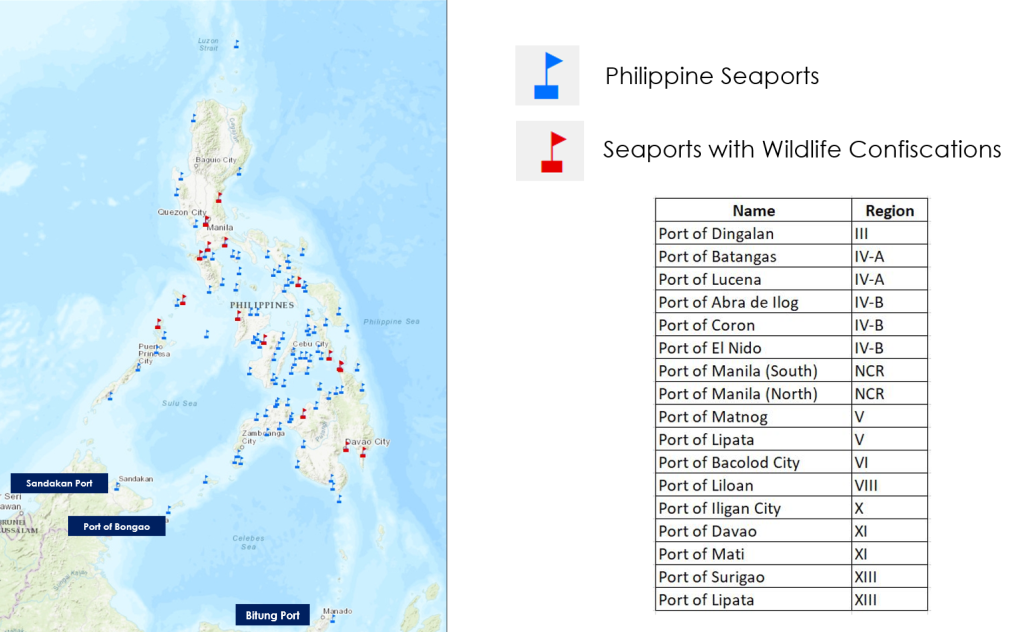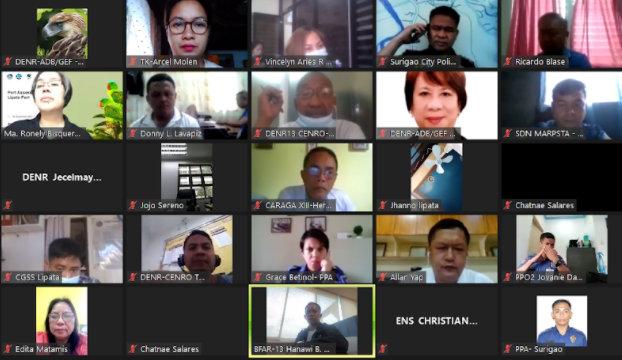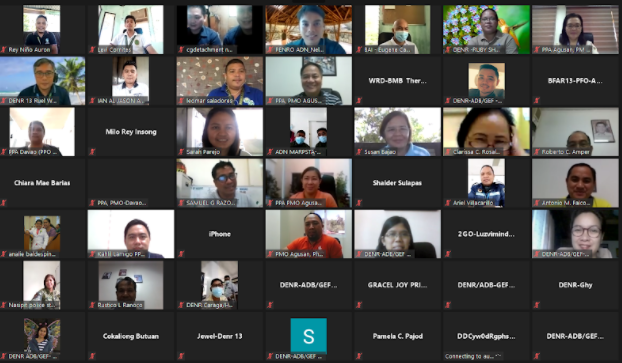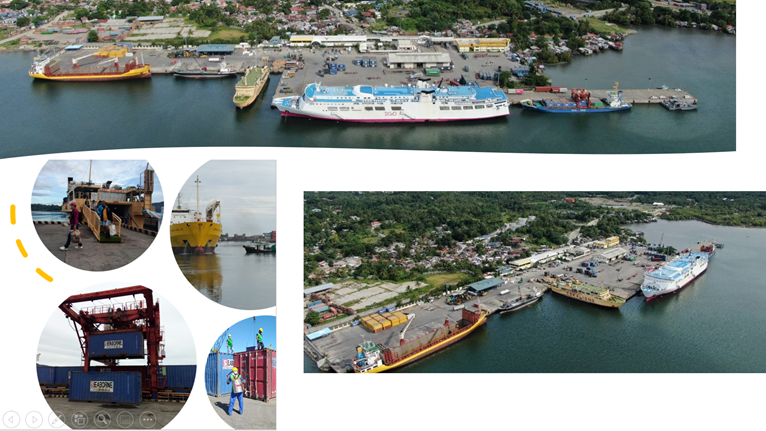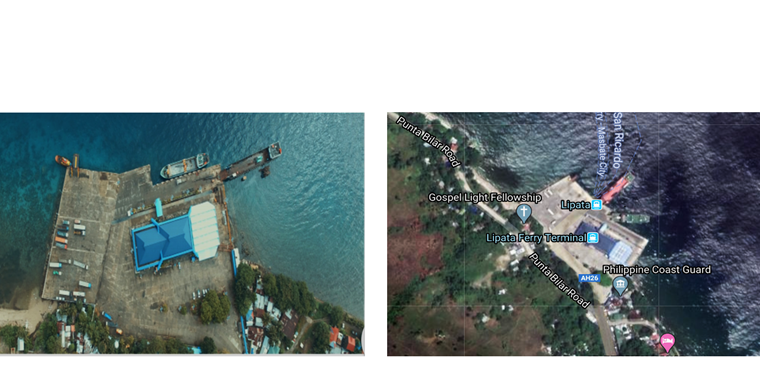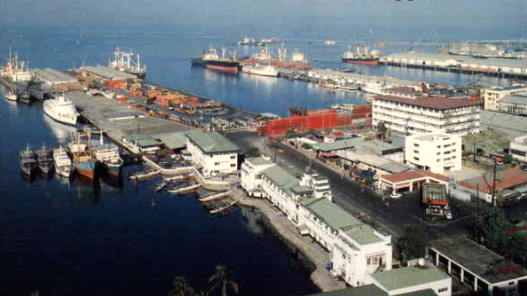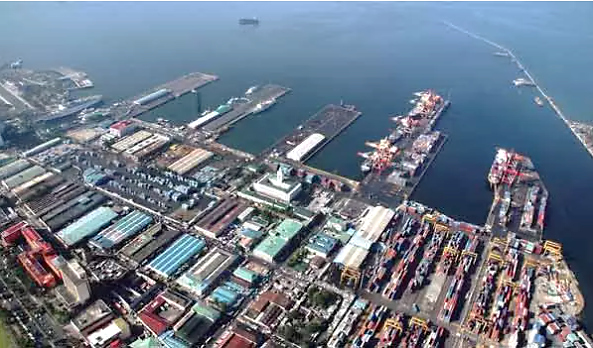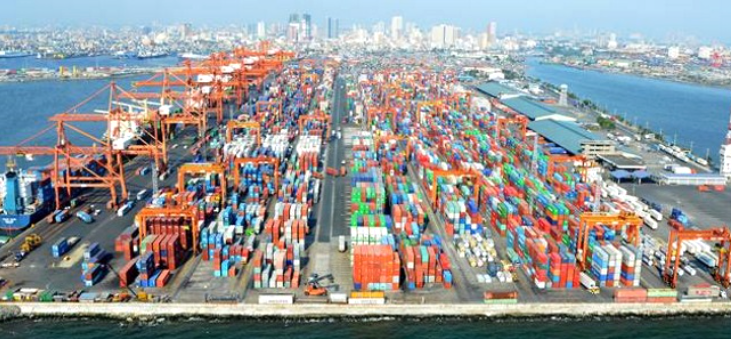Illegal wildlife trade (IWT) is a serious threat to biodiversity, economies, and communities. It is the fourth largest transnational crime in the world after narcotics, human trafficking, and arms, with an estimated value of USD 10-23 billion per year (UNEP, 2016) .
Wildlife traffickers and organized criminal syndicates are increasingly using seaports as transshipment points for IWT. This is due to the large volume of goods processed daily, coupled by the lack of adequate infrastructure, systems, and manpower that, ultimately, make it difficult to detect cases of IWT in domestic and international ports.
Data from the Department of Environment and Natural Resources-Biodiversity Management Bureau (DENR-BMB) show that of the 337 seaports registered with the Philippine Ports Authority (PPA), 17 had cases of wildlife confiscations from 2010-2020. This number only reflects actual seizures in ports, and it is believed that more cases of illicit wildlife trade remain undetected.
CARAGA and NCR Port Assessments
Five key seaports were recently assessed for readiness to respond to wildlife trafficking. In CARAGA Region, these are Lipata Port in Surigao Del Norte Province (assessed on November 11-16, 2020) and Nasipit Port in Agusan Del Norte (November 18-23, 2020). In the National Capital Region (NCR), these included the Port of Manila: Manila North Harbor (November 25-December 1, 2020), Manila South Harbor (January 18-22, 2021), and Manila International Container Terminal (MICT) (January 25-29, 2021).
The Port Monitoring and Anti-Trafficking Evaluation (PortMATE) Tool was used in the assessment workshops. PortMATE is a standardized instrument with 52 questions across nine categories: 1) electronic customs declaration system, 2) intelligence, 3) risk profiling system, 4) container/cargo scanning, 5) container/cargo inspection, 6) investigation and prosecution, 7) inter-agency and institutional collaboration, 8) employee integrity and anti-corruption, 9) supply chain and security. The workshops aimed to determine the readiness of the said ports, including the government agencies managing and manning the same, to monitor and track wildlife trafficking. It is used to spot key gaps at the port level, identify interventions to address the gaps, as well as monitor and track improvements across time.
Representatives from the PPA, DENR Field Offices, Bureau of Customs, Bureau of Animal Industry, Bureau of Plant Industry, Bureau of Fisheries and Aquatic Resources, Philippine Coast Guard, Philippine National Police, Philippine National Police-Maritime Group, and the private sector attended the workshops.
In his Message, DENR Assistant Secretary and concurrent BMB Director Ricardo Calderon recognized that, as an archipelago, the Philippines has porous borders and that, in past years, has become an origin, destination and transshipment points for wildlife trafficking due to its strategic location.
He enjoined all the participants to work together to stop wildlife crimes. “One or two agencies are relatively powerless to defeat the powerful, well-organized transnational crime syndicates. However, by working together, we can ensure greater success,” Mr. Calderon said.
Dr. Francesco Ricciardi of the Asian Development Bank (ADB) shared that aside from being pathways, ports could serve as bottlenecks for IWT, too. “We can effectively disrupt the illegal trade of wildlife by introducing and strengthening systems and mechanisms to detect and intercept contraband, including wildlife,” Dr. Ricciardi said.
PPA General Manager Atty. Jay Daniel Santiago, in his message during the Manila North Harbor assessment, said that PPA stands ready to work with different stakeholders to come up with an integrated approach in combating illegal activities, including IWT, in all ports. “We must unite and act together to secure the future generations of the Philippines,” Atty. Santiago added.
Port Manager Froilan Caturla of Surigao Port relayed PPA’s commitment to provide all necessary support to prevent traffickers from using or transiting in their ports. He asked for the continued support and vigilance of port stakeholders—the shipping lines, cargo handling operators, porters, among others—to make this happen.
On the other hand, Nasipit Port Manager Mildred Padilla shared her appreciation for the conduct of the assessment, noting that PortMATE is helpful in identifying capacity building measures they can undertake. “We in Nasipit Port commit to give full support to this activity. Our Port Police and Port Operations Division are in attendance to cooperate in this undertaking because this is our little contribution in the effort to protect wildlife. Together, we can do so much more,” Ms. Padilla said.
Manila South Harbor and MICT Port Manager Eligio Fortajada shared that preserving wildlife species is akin to preserving the national identity of the Philippines. “The port assessment will help the Port Management Office (PMO) of South Harbor and MICT in identifying deficiencies and improvements,” Mr. Fortajada added.
Key findings
Among the key findings of the abovementioned assessment workshops are: 1) absence of a single window environment for Electronic Clearance System; 2) lack of intelligence and intelligence access on a regional scale that may help the early detection and interception of wildlife contrabands entering the port; 3) lack of risk profiling system complemented with wildlife crime risk indicators; 4) absence of a K9 Unit able to detect wildlife, by-products, and derivatives; 5) presence of established standard operating procedures for inspection and seizure of wildlife and other illicit goods; 6) presence of a protocol on post seizure investigation of cases; 7) presence of an information exchange system with local ports (for PPA) but under-maximized communication exchange with international institutions; 8) presence of an established system to maintain employees’ integrity, professional standards and to deter corrupt practices; and, 9) presence and participation of industry operators, and need for greater cooperation and support from other supply chains. The workshops also identified the need for trainings in the following areas: a) interpreting wildlife images in scanning machines, concealment and detection; b) analysis of wildlife trafficking patterns; c) wildlife laws and CITES regulations, wildlife identification, wildlife forensics, controlled delivery; and, d) serving as witness in court for law enforcement agencies.
A Memorandum of Understanding (MOU) between the DENR-Biodiversity Management Bureau and the PPA was executed on July 13, 2020 to deter and combat wildlife trafficking in all ports within the jurisdiction and supervision of the PPA, including support for the conduct of the assessment workshops, as well as future trainings to build capacity.
The abovementioned initiatives are part of the support provided by the Project on Combating Environmental Organized Crime in the Philippines, a three-year Global Environment Facility (GEF)-6-funded project executed by the DENR-BMB, with the Asian Development Bank (ADB) as the GEF Implementing Agency. It aims to combat environmental organized crime in the Philippines through legal and institutional reforms, capacity building in the full law enforcement chain, and reduction of demand for illegal wildlife and wildlife parts and derivatives.
